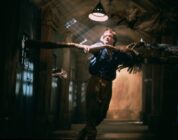In the history of horror games – beginning with Haunted House and Monster Maze, going right up to Dying Light The Beast and Silent Hill F – Resident Evil 4 marks an inflection point. I’ll personally maintain that RE was an action game right from the beginning, as far back as 1996. But Resident Evil 4 undoubtedly tipped the scale. Survival horror was joined by a new subgenre: action horror. Superficially, they might seem mutually exclusive. If survival horror games like Silent Hill and classic RE are built around a fixed camera, a limited inventory, and a short supply of bullets, action horror, a la Dead Space and Dying Light, is the quick-paced, spectacular spiritual opposite. And yet Holstin, one of the most wishlisted upcoming horror games on Steam right now, manages to marry the two disciplines.
It’s eastern Poland, it’s 1992, and your best friend has gone missing. Everywhere you search for him, a creeping, sentient ooze has overrun both the local architecture and the population. Streets and doors are blocked by giant, slimy growths. People covered in orange pustules are trying to kill you – even those lucky enough to remain uninfected seem to be slowly slipping free of sanity. Some of Holstin‘s levels are straightforward and linear. Others are more open ended, and set you loose into a hub world to meet NPCs and complete assignments for them in whatever order you choose.
What doesn’t change is the pervasive sense of dread. Dark, claustrophobic, and perpetually strange, the world of Holstin is reminiscent of the classic incarnations of Silent Hill, where a grotesque kind of normality subsists alongside abject nightmarishness.
Mechanically, too, Holstin largely feels like a traditional survival horror game. You find a locked door. There’s a note. The note leads to a puzzle. The puzzle leads to a key. The key unlocks the door. Supplies aren’t limited, but there’s at least an illusory sense of scarcity. Instead of ink ribbons, you have phone cards. Health is regained with herbs. But Holstin has a trick up its sleeve.
Rather than it being truly fixed, at any time, you can rotate the camera between eight different angles. When you get into a fight and aim your weapon, the perspective jumps to behind your character’s shoulder, just like Resident Evil 4. The effect is a visual hybrid of old-school, pre-rendered-background-style survival horror and more modern, combat-driven action horror.
If the world of Holstin is supposed to be twisted, abstract, and bizarre, the experience of playing it is suitably disorientating. You won’t get lost, but as your literal perspective constantly and rapidly shifts, it becomes a metaphor for the bewildering and pliable unreality around you.

Horror games will often encounter the same spiritual problem. While tonally or narratively they’re rooted in nightmare logic, cosmic terror, and surrealism, they’re games, and games are formally premised on mechanics and systems. It’s hard to do abstract (the monster pursuing you in Amnesia is horrific beyond description) when you also have to do computational, and pragmatic (but you can always avoid it so long as you stand in a patch of shadow).
Holstin unites two horror types that are typically disparate. It also makes an effort to mitigate one of the fundamental structural problems at the genre’s core. We don’t have a release date yet, but you can try Holstin for yourself right here.
Otherwise, you might want to get some of the best survival games, or maybe the best zombie games available on PC today.
You can follow us on Google News for daily PC games news, reviews, and guides. We’ve also got a vibrant community Discord server, where you can chat about this story with members of the team and fellow readers.





